Reconstructing of Embedded High-Aspect-Ratio Nano-Voids Generated by Ultrafast Laser Bessel Beams
Abstract
1. Introduction
2. Experimental Setup
2.1. Materials
2.2. Preparation of the High-Aspect-Ratio Nano-Holes with Bessel Beams
2.3. Measurement and Characterization
3. Reconstruction and Effect of Pulse Duration on the Inside Nano-Structure
4. Discussion about Nano-Structure on Exit Surface
4.1. Effect of Pulse Energy and Pulse Width on Exit Surface Nano-Structure
4.2. Effect of Relative Position of the Pulse Beams to the Exit Surface on Nano-Structure
5. Conclusions
Author Contributions
Funding
Conflicts of Interest
References
- Durnin, J.; Miceli, J.J.; Eberly, J.H. Diffraction-free beams. Phys. Rev. Lett. 1987, 58, 1499–1501. [Google Scholar] [CrossRef] [PubMed]
- Sheppard, C.J.R.; Wilson, T. Gaussian-beam theory of lenses with annular aperture. J. Microw. Opt. Acoust. 1978, 2, 105–112. [Google Scholar] [CrossRef]
- McLeod, J.H. The axicon: A new type of optical element. J. Opt. Soc. Am. 1954, 44, 592–597. [Google Scholar] [CrossRef]
- Herman, R.M.; Wiggins, T.A. Production and uses of diffractionless beams. J. Opt. Soc. Am. A 1991, 8, 932–942. [Google Scholar] [CrossRef]
- Gori, F.; Guattari, G.; Padovani, C. Bessel-Gauss beams. Opt. Commun. 1987, 64, 491–495. [Google Scholar] [CrossRef]
- Stoian, R.; Bhuyan, M.K.; Rudenko, A.; Colombier, J.P.; Cheng, G. High-resolution material structuring using ultrafast laser non-diffractive beams. J. Adv. Phys. X 2019, 4, 1659180. [Google Scholar] [CrossRef]
- Stoian, R.; Bhuyan, M.K.; Zhang, G.; Cheng, G.; Meyer, R.; Courvoisier, F. Ultrafast Bessel beams: Advanced tools for laser materials processing. Adv. Opt. Technol. 2018, 7, 165–174. [Google Scholar] [CrossRef]
- Bhuyan, M.K.; Velpula, P.K.; Colombier, J.; Olivier, T.; Faure, N.; Stoian, R. Single-shot high aspect ratio bulk nanostructuring of fused silica using chirp-controlled ultrafast laser Bessel beams. Appl. Phys. Lett. 2014, 104, 021107. [Google Scholar] [CrossRef]
- Mitra, S.; Chanal, M.; Clady, R.; Mouskeftaras, A.; Grojo, D. Millijoule femtosecond micro-Bessel beams for ultra-high aspect ratio machining. Appl. Opt. 2015, 54, 7358–7365. [Google Scholar] [CrossRef]
- Meyer, R.; Froehly, L.; Giust, R.; Del Hoyo, J.; Furfaro, L.; Billet, C.; Courvoisier, F. Extremely high-aspect-ratio ultrafast Bessel beam generation and stealth dicing of multi-millimeter thick glass. Appl. Phys. Lett. 2019, 114, 201105. [Google Scholar] [CrossRef]
- Zhang, G.; Stoian, R.; Zhao, W.; Cheng, G. Femtosecond laser Bessel beam welding of transparent to non-transparent materials with large focal-position tolerant zone. Opt. Express 2018, 26, 917–926. [Google Scholar] [CrossRef]
- Jenne, M.; Flamm, D.; Ouaj, T.; Hellstern, J.; Grossmann, D.; Kumkar, M.; Nolte, S. Glass cutting optimization with pump-probe microscopy and Bessel beam profiles. Proc. SPIE 2018, 10522, 1052216. [Google Scholar]
- Jenne, M.; Flamm, D.; Ouaj, T.; Hellsern, J.; Kleiner, J.; Grossmann, D.; Koschig, M.; Kaiser, M.; Kumkar, M.; Nolte, S. High-quality tailored-edge cleaving using aberration-corrected Bessel-like beams. Opt. Lett. 2018, 43, 2164–2167. [Google Scholar] [CrossRef] [PubMed]
- Courvoisier, F.; Couairon, A.; Stoian, R. Ultrafast laser micro- and nano-processing with nondiffracting and curved beams. Opt. Laser Technol. 2016, 80, 125–137. [Google Scholar] [CrossRef]
- Miyamoto, I.; Sugioka, K.; Sigmon, T.W. Laser precision microfabrication. Laser Precis. Microfabr. 2000, 135, 1–8. [Google Scholar]
- Rapp, L.; Meyer, R.; Giust, R.; Furfaro, L.; Jacquot, M.; Lacourt, P.A.; Dudley, J.M.; Courvoisier, F. High aspect ratio micro-explosions in the bulk of sapphire generated by femtosecond Bessel beams. Sci. Rep. 2016, 6, 34286. [Google Scholar] [CrossRef]
- Sudrie, L.; Couairon, A.; Franco, M.; Lamouroux, B.; Prade, B.; Tzortzakis, S.; Mysyrowicz, A. Femtosecond Laser-Induced Damage and Filamentary Propagation in Fused Silica. Phys. Rev. Lett. 2002, 89, 186601. [Google Scholar] [CrossRef] [PubMed]
- Liu, X.; Sanner, N.S.; Sentis, M.; Stoian, R.; Zhao, W.; Cheng, G.; Utéza, O. Front-surface fabrication of moderate aspect ratio micro-channels in fused silica by single picosecond Gaussian-Bessel laser pulse. Appl. Phys. A 2018, 124, 206. [Google Scholar] [CrossRef]
- Liu, X.; Li, Q.; Sikora, A.; Sentis, M.; Uteza, A.; Stoian, R.; Zhao, W.; Cheng, G.; Sanner, N. Truncated Gaussian-Bessel beams for short-pulse processing of small-aspect-ratio micro-channels in dielectrics. Opt. Express 2019, 27, 6996–7008. [Google Scholar] [CrossRef]
- Meyer, R.; Jacquot, M.; Giust, R.; Safioui, J.; Rapp, L.; Furfaro, L.; Lacourt, P.A.; Dudley, J.M.; Courvoisier, F. Single-shot ultrafast laser processing of high-aspect-ratio nanochannels using elliptical Bessel beams. Opt. Lett. 2017, 43, 4307–4310. [Google Scholar] [CrossRef]
- He, F.; Yu, J.J.; Tan, Y.X.; Chu, W.; Zhou, C.H.; Cheng, Y.; Sugioka, K. Tailoring femtosecond 1.5-μm Bessel beams for manufacturing high-aspect-ratio through-silicon vias OPEN. J. Sci. Rep. 2017, 7, 40785. [Google Scholar] [CrossRef] [PubMed]
- Zhang, G.; Cheng, G.; Bhuyan, M.K.; D’Amico, C.; Stoian, R. Ultrashort Bessel beam photoinscription of Bragg Gratings waveguides and their application as temperature sensor. Photonics Res. 2019, 7, 2327. [Google Scholar] [CrossRef]
- Gamaly, E.G.; Juodkazis, S.; Nishimura, K.; Misawa, H.; Luther-Davies, B.; Hallo, L.; Nicolai, P.; Tikhonchuk, T.V. Laser-matter interaction in the bulk of a transparent solid: Confined microexplosion and void formation. Phys. Rev. B Condens. Matter Mater. Phys. 2006, 73, 214101. [Google Scholar] [CrossRef]
- McGloin, D.; Dholakia, K. Bessel beams: Diffraction in a new light. Contemp. Phys. 2005, 46, 15–28. [Google Scholar] [CrossRef]
- Duocastella, D.; Arnold, C.B. Bessel and annular beams for materials processing. Laser Photonics Rev. 2012, 6, 607–621. [Google Scholar] [CrossRef]
- Mauclair, C.; Mermillod-Blondin, A.; Huot, N.; Audouard, E.; Stoian, R. Ultrafast laser writing of homogeneous longitudinal waveguides in glasses using dynamic wavefront correction. Opt. Express 2008, 16, 5481–5492. [Google Scholar] [CrossRef] [PubMed]
- Bhuyan, M.K.; Courvoisier, F.; Lacourt, P.A.; Jacquot, M.; Dudley, J.M. High aspect ratio taper-free microchannel fabrication using femtosecond Bessel beams. Opt. Express 2010, 18, 566–574. [Google Scholar] [CrossRef] [PubMed]
- Zhang, G.; Cheng, G.; Bhuyan, M.; D’Amico, C.; Stoian, R. Efficient point-by-point Bragg gratings fabricated in embedded laser-written silica waveguides using ultrafast Bessel beams. Opt. Lett. 2018, 43, 2161–2164. [Google Scholar] [CrossRef] [PubMed]
- Burakov, I.M.; Bulgakova, N.M.; Stoian, R.; Mermillod-Blondin, A.; Audouard, E.; Rosenfeld, A.; Husakou, A.; Hertel, I.V. Spatial distribution of refractive index variations induced in bulk fused silica by single ultrashort and short laser pulses. J. Appl. Phys. 2007, 101. [Google Scholar] [CrossRef]
- Gadonas, R.; Jarutis, V.; Paškauskas, R.; Smilgevicius, A.; Stabinis, A.; Vaicaitis, V. Self-action of Bessel beam in nonlinear medium. Opt. Commun. 2001, 196, 309–316. [Google Scholar] [CrossRef]
- Faccio, D.; Rubino, E.; Lotti, A.; Couairon, A.; Tamosauskas, G.; Papazoglou, D.G. Nonlinear light-matter interaction with femtosecond high-angle Bessel beams. Phys. Rev. A 2012, 85, 033829. [Google Scholar] [CrossRef]
- Doring, S.; Szilagyi, J.; Richter, S.; Zimmermann, F.; Richardson, M.; Tünnermann, A.; Nolte, S. Evolution of hole shape and size during short and ultrashort pulse laser deep drilling. Opt. Express 2012, 20, 27147–27154. [Google Scholar] [CrossRef] [PubMed]
- Polesana, P.; Franco, M.; Couairon, A.; Faccio, D.; Trapani, P.D. Filamentation in Kerr media from pulsed Bessel beams. Phys. Rev. A 2008, 77, 043814. [Google Scholar] [CrossRef]
- Juodkazis, S.; Nishimura, K.; Tanaka, S.; Misawa, H.; Gamaly, E.G.; Luther, D.B.; Hallo, L.; Nicolai, P.; Tikhonchuk, V.T. Laser-induced microexplosion in the bulk of a sapphire crystal: Evidence of Mb pressures. Phys. Rev. Lett. 2006, 96, 166101. [Google Scholar] [CrossRef] [PubMed]
- Velpula, P.K.; Bhuyan, M.K.; Courvoisier, F.; Zhang, H.; Colombier, J.P.; Stoian, R. Spatio-temporal dynamics in nondiffractive Bessel ultrafast laser nanoscale volume structuring. Laser Photonics Rev. 2016, 10, 230–244. [Google Scholar] [CrossRef]
- Bhuyan, M.K.; Somayaji, M.; Mermillod-Blondin, A.; Bourquard, F.; Colombier, J.P.; Stoian, R. Ultrafast laser nanostructuring in bulk silica, a “slow” microexplosion. Optica 2017, 4, 951. [Google Scholar] [CrossRef]
- Yu, Y.; Jiang, L.; Cao, Q.; Xia, B.; Wang, Q.; Lu, Y. Pump-probe imaging of the fs-ps-ns dynamics during femtosecond laser Bessel beam drilling in PMMA. Opt. Express 2015, 23, 32728–32735. [Google Scholar] [CrossRef]
- Cao, Q.; Zhang, J.J.; Du, J.; Zhao, H.M.; Liu, S.; Peng, Q. Athermal repair of nanoscale defects in optical materials using a femtosecond laser. Nanoscale 2017, 9, 17233–17240. [Google Scholar] [CrossRef]
- Kraus, R.G.; Stewart, S.T.; Swift, D.C.; Bolme, C.A.; Smith, R.F.; Hamel, S.; Hammel, B.D.; Spaulding, D.K.; Hicks, D.G.; Eggert, J.H.; et al. Shock vaporization of silica and the thermodynamics of planetary impact events. J. Geophys. Res. 2012, 117, E09009. [Google Scholar] [CrossRef]
- Mermillod-Blondin, A.; Burakov, I.M.; Meshcheryakov, Y.P.; Bulgakova, N.M.; Audouard, E.; Rosenfeld, A.; Husakou, A.; Hertel, I.V.; Stoain, R. Flipping the sign of refractive index changes in ultrafast and temporally shaped laser-irradiated borosilicate crown optical glass at high repetition rates. Phys. Rev. B 2008, 77, 104205. [Google Scholar] [CrossRef]
- Venkatakrishnan, K.; Vipparty, D.; Tan, B. Nanofibre fabrication by femtosecond laser ablation of silica glass. Opt. Express 2011, 19, 15770–15776. [Google Scholar] [CrossRef] [PubMed]
- Manickam, S.; Venkatakrishnan, K.; Tan, B.; Venkataramanan, V. Study of silicon nanofibrous structure formed by femtosecond laser irradiation in air. Opt. Express 2009, 17, 13869–13874. [Google Scholar] [CrossRef]
- Stuart, B.C.; Feit, M.D.; Herman, S.; Rubenchik, A.M.; Shore, B.W.; Perry, M.D. Optical ablation by high-power short-pulse lasers. J. Opt. Soc. Am. B 1996, 13, 459–468. [Google Scholar] [CrossRef]
- Perry, M.D.; Stuart, B.C.; Banks, P.S.; Feit, M.D.; Yanovsky, V.; Rubenchik, A.M. Ultrashort-pulse laser machining of dielectric materials. J. Appl. Phys. 1999, 85, 6803–6810. [Google Scholar] [CrossRef]
- Amako, J.; Sawaki, D.; Fujii, E. Microstructuring transparent materials by use of nondiffracting ultrashort pulse beams generated by diffractive optics. J. Opt. Soc. Am. B 2003, 20, 2562. [Google Scholar] [CrossRef]
- Wang, J.; Rajendran, A.M.; Dongare, A.M. Atomic scale modeling of shock response of fused silica and a-quartz. J. Mater Sci. 2015, 50, 8128–8141. [Google Scholar] [CrossRef]
- Grady, D.E. The spall strength of condensed matter. J. Mech. Phys. Solids 1988, 36, 353–384. [Google Scholar] [CrossRef]
- Uteza, O.; Sanner, N.; Chimier, B.; Brocas, A.; Varkentina, N.; Sentis, M.; Lassonde, P.; Legare, F.; Kieffer, J.C. Control of material removal of fused silica with single pulses of few optical cycles to sub-picosecond duration. J. Appl. Phys. A 2011, 105, 131–141. [Google Scholar] [CrossRef]
- Melosh, H.J. Hydrocode equation of state for SiO2. Meteorit. Planet. Sci. 2007, 42, 2079–2098. [Google Scholar] [CrossRef]
- Medvedev, A.B. Equation of state of silicon dioxide with allowance for evaporation, dissociation, and ionization. Combust. Explos. Shock Waves 2016, 52, 463–475. [Google Scholar] [CrossRef]
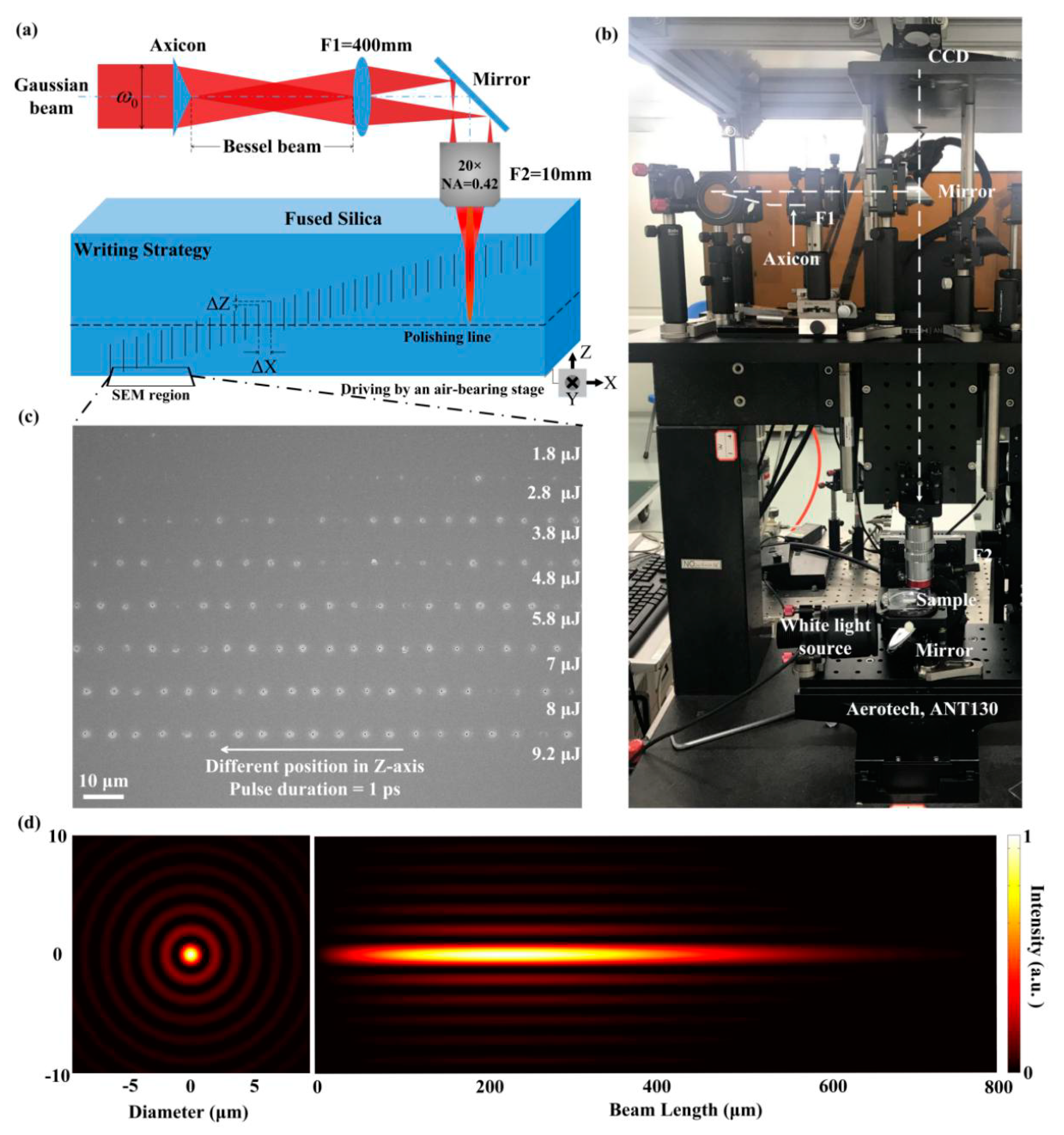


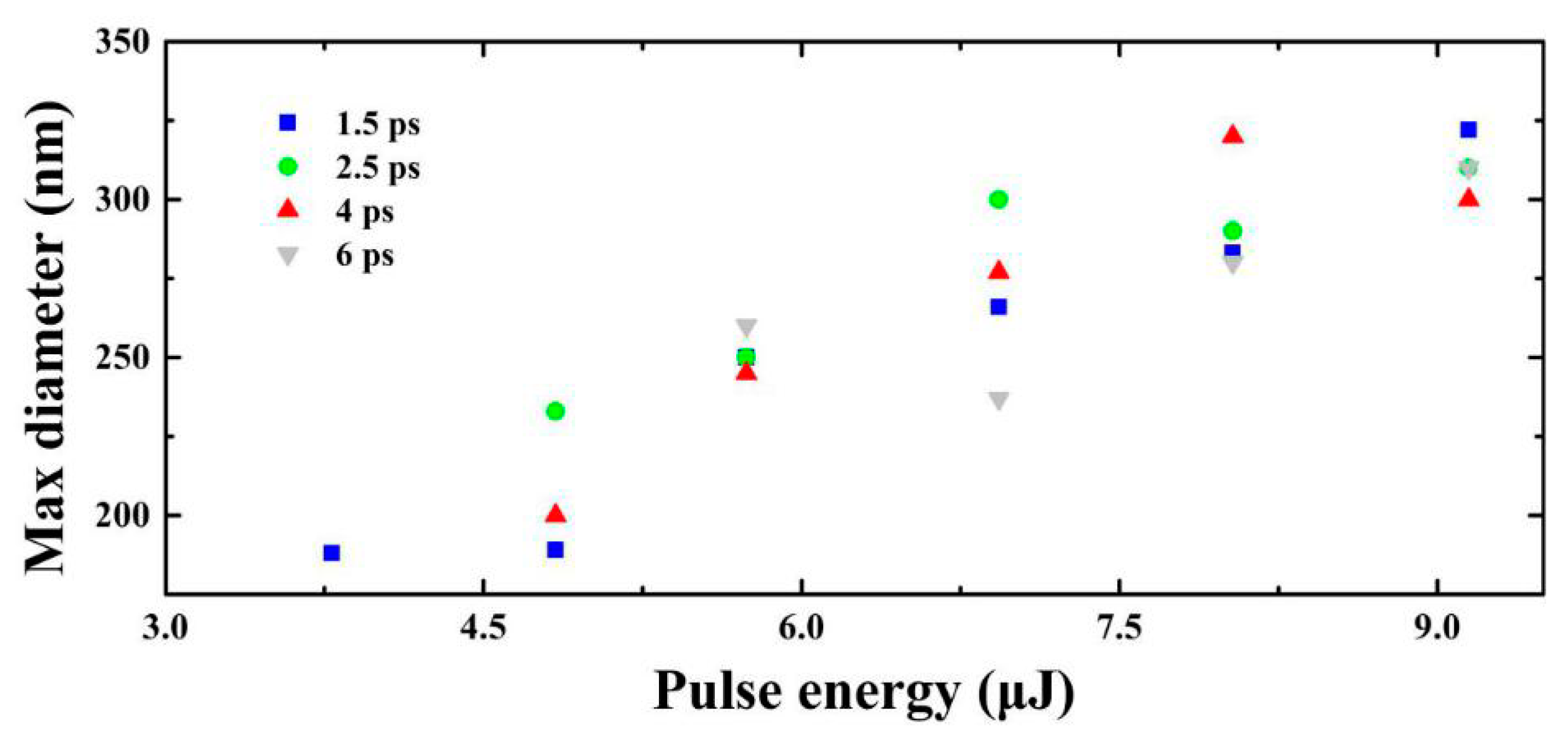
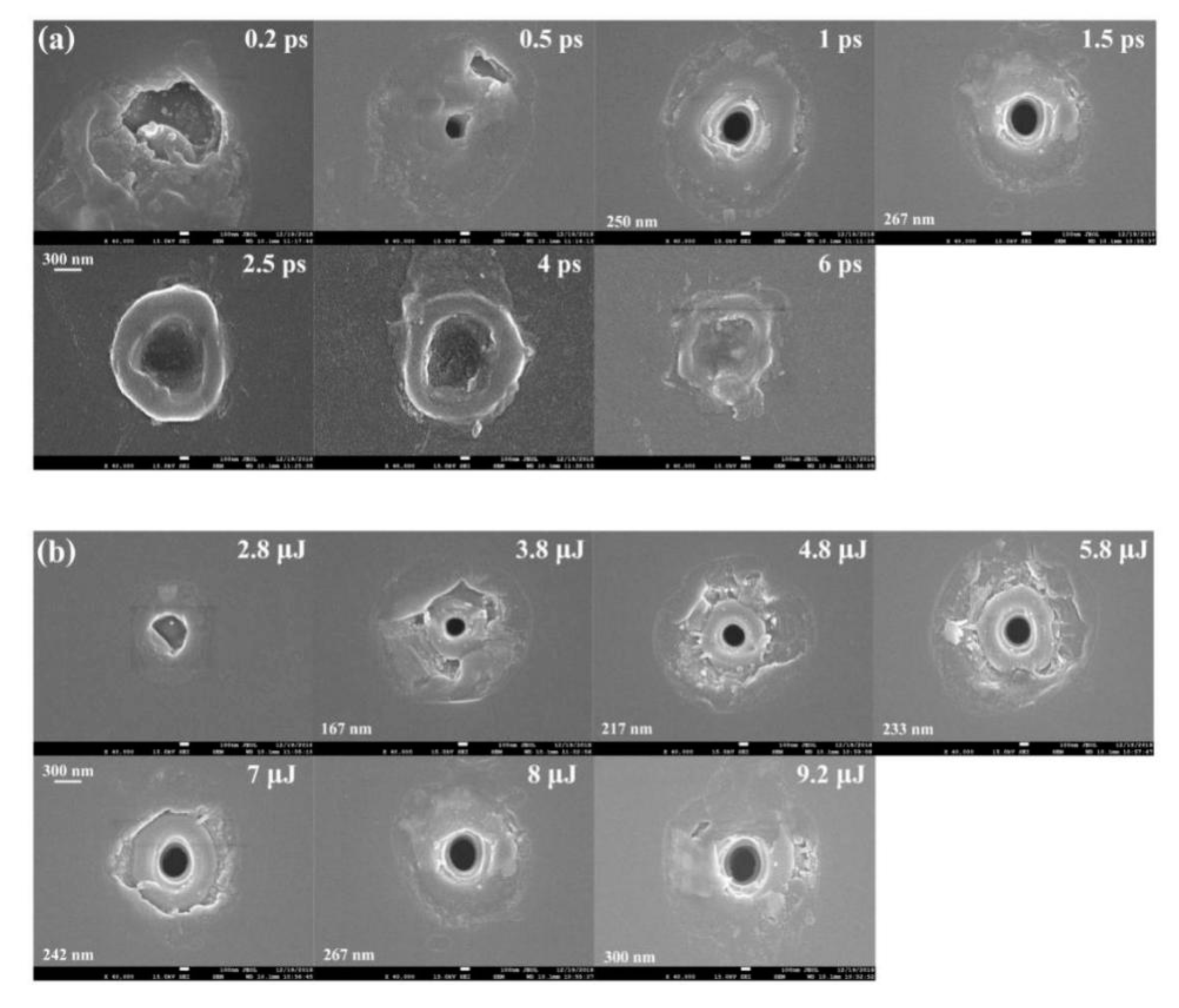
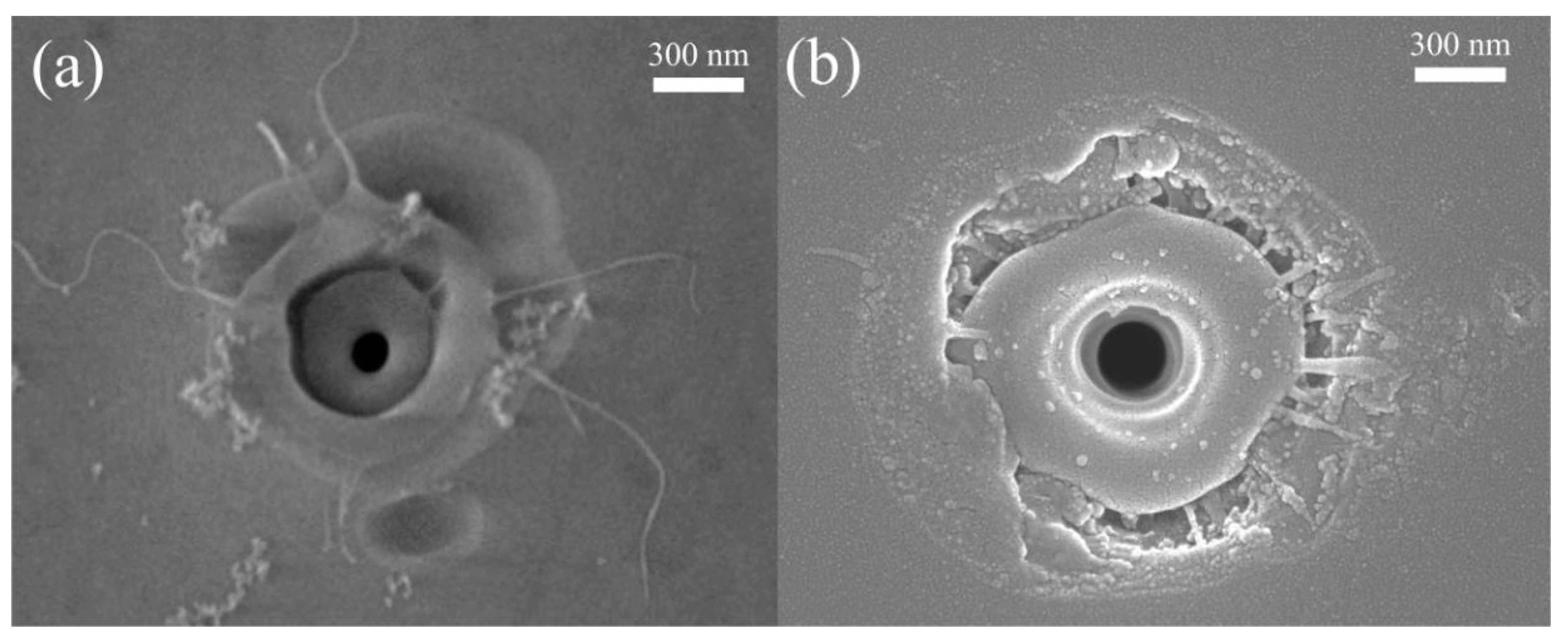
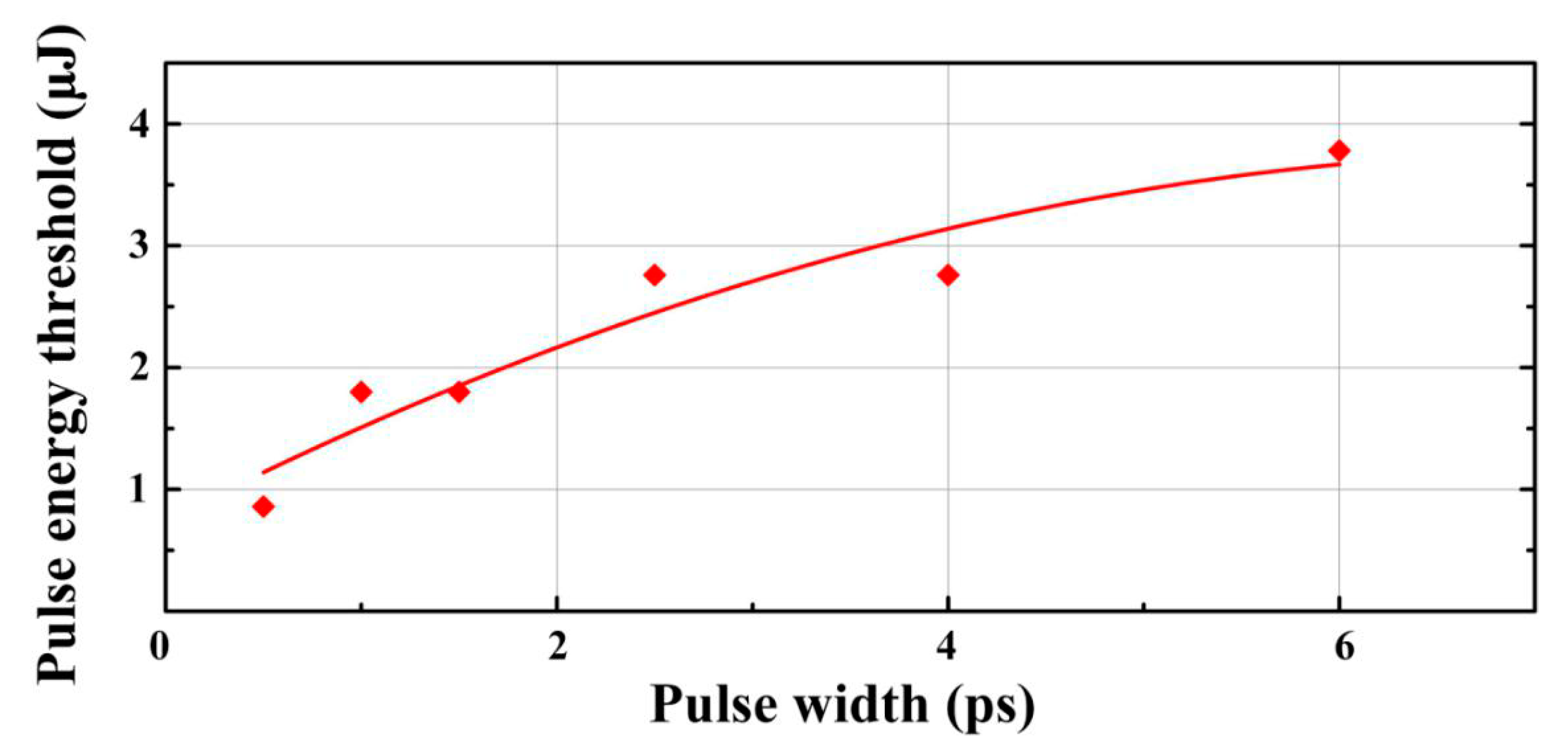
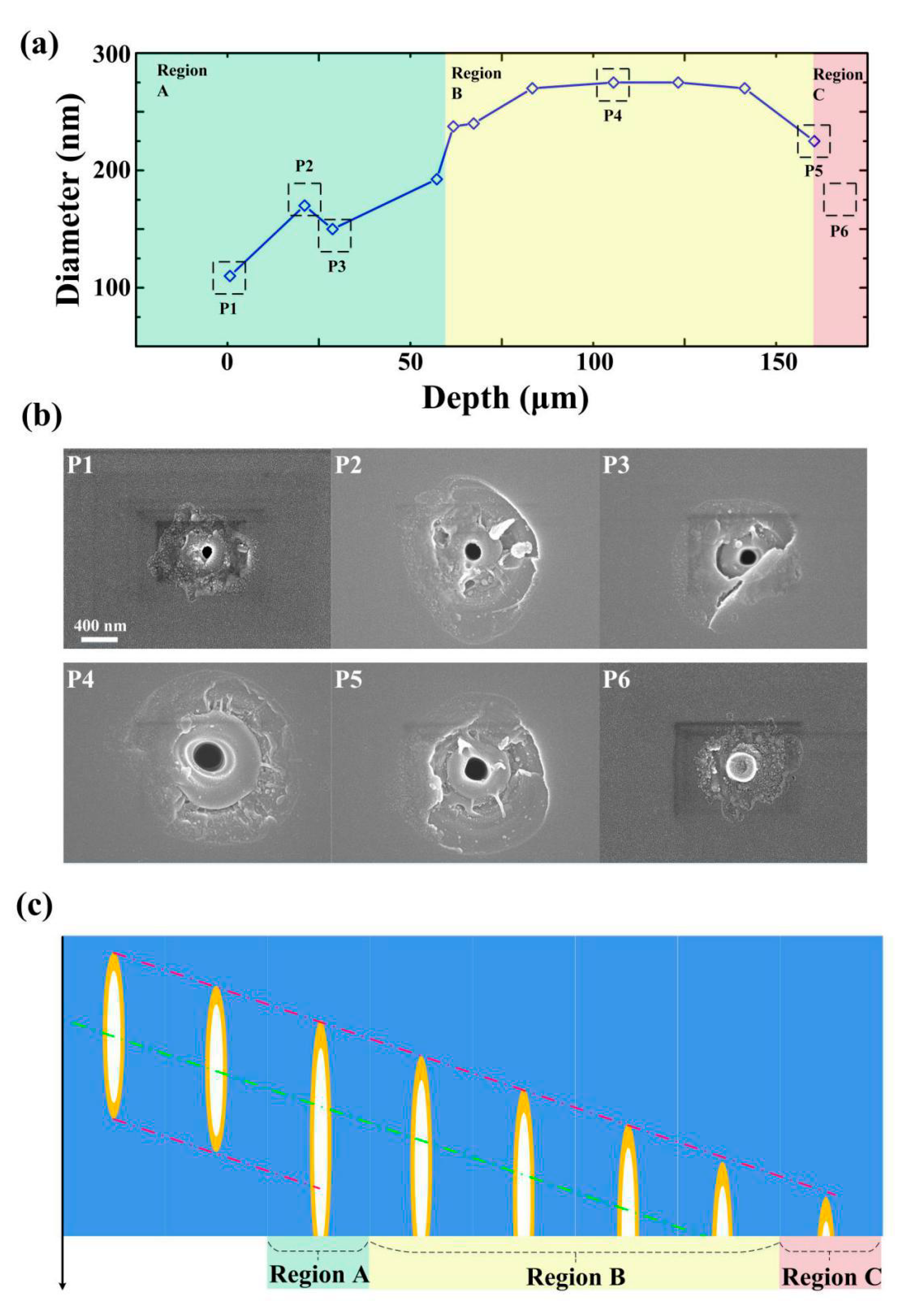
© 2020 by the authors. Licensee MDPI, Basel, Switzerland. This article is an open access article distributed under the terms and conditions of the Creative Commons Attribution (CC BY) license (http://creativecommons.org/licenses/by/4.0/).
Share and Cite
Chen, T.; Zhang, G.; Wang, Y.; Li, X.; Stoian, R.; Cheng, G. Reconstructing of Embedded High-Aspect-Ratio Nano-Voids Generated by Ultrafast Laser Bessel Beams. Micromachines 2020, 11, 671. https://doi.org/10.3390/mi11070671
Chen T, Zhang G, Wang Y, Li X, Stoian R, Cheng G. Reconstructing of Embedded High-Aspect-Ratio Nano-Voids Generated by Ultrafast Laser Bessel Beams. Micromachines. 2020; 11(7):671. https://doi.org/10.3390/mi11070671
Chicago/Turabian StyleChen, Tianqu, Guodong Zhang, Yishan Wang, Xuelong Li, Razvan Stoian, and Guanghua Cheng. 2020. "Reconstructing of Embedded High-Aspect-Ratio Nano-Voids Generated by Ultrafast Laser Bessel Beams" Micromachines 11, no. 7: 671. https://doi.org/10.3390/mi11070671
APA StyleChen, T., Zhang, G., Wang, Y., Li, X., Stoian, R., & Cheng, G. (2020). Reconstructing of Embedded High-Aspect-Ratio Nano-Voids Generated by Ultrafast Laser Bessel Beams. Micromachines, 11(7), 671. https://doi.org/10.3390/mi11070671



